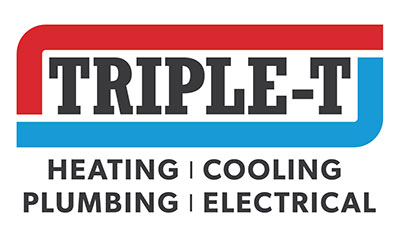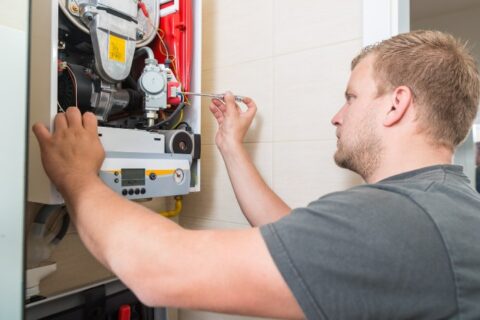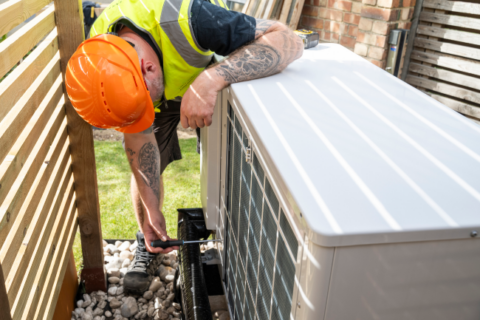Do Centralized Air Conditioning Systems Bring in Fresh Air?
Even though most people count on heating, ventilation, and air conditioning (HVAC) for indoor comfort, the basic operating mechanics of these systems are greatly misunderstood. For instance, a common belief is that AC units pull in air from outside, cool it, and circulate it around the house. But this is not how air conditioning works. Instead, it is a heat exchange process that removes unwanted thermal energy from the indoor air and exhausts it outside. With this in mind, learn more about how your air conditioner cools your home and whether you need additional ventilation to promote good indoor air quality.
Air Conditioners Don’t Bring in Fresh Air
Half of your central air conditioning system, known as the evaporator coil, is located inside near the furnace. The other half, known as the condensing unit, sits on a concrete slab outside your house. Because of its exterior location, it’s reasonable to assume the condensing unit pulls in fresh air. In reality, this component exhausts heat outside.
It’s important to understand that only thermal energy, not air itself, passes between the inside and outside units. This means the air blowing from the supply vents around your house does not come from outside; instead, indoor air circulates to the evaporator coil through the return vents, where it gives up its heat before flowing out of the supply vents. Likewise, hot indoor air does not exhaust outside; only the thermal energy collected from the air is exhausted. All this is possible thanks to refrigerant.
How Does Refrigerant Work?
Air conditioning and refrigeration rely on a specialized fluid called refrigerant. Contained in a closed-loop system, refrigerant continuously extracts heat from indoor air and shuttles it outside throughout the cooling cycle. This heat exchange process requires the refrigerant to undergo a series of changes in temperature, pressure, and state. Here’s how it works:
- Cold, liquid refrigerant enters the indoor evaporator coil. As warm indoor air blows over the coil, the refrigerant absorbs heat and evaporates into a heated, gaseous state. The newly-cooled air is now distributed throughout the house using a blower and ductwork.
- Once it has absorbed heat, the refrigerant passes through a compressor, where the gas is pressurized and heated even more. This important step prepares the refrigerant to give up its heat.
- Very hot gaseous refrigerant flows into the outdoor condensing coil, expelling the heat it collected from inside with the help of a large fan and metal fins that act as heat sinks. The refrigerant loses thermal energy to the outdoor air and condenses back into a liquid.
- On its way back inside, the refrigerant passes through an expansion valve, which depressurizes the liquid refrigerant and causes the temperature to plummet. This essential step prepares the refrigerant to absorb heat, beginning the cycle all over again.
Once you understand the refrigeration cycle, it makes sense that half of your air conditioning system must sit outside. It also explains why room AC units must sit in a window—not to pull fresh air inside but to pump thermal energy outside. If you run a window air conditioner without installing it in a window first, you’ll feel cold air blow out the front and hot air exhaust out the back.
Does This Mean I Need Additional Ventilation?
The answer to this question depends on how tightly your home is built and your indoor air quality needs. Homes built more than a decade or two ago often have enough leaks to facilitate a reasonable air exchange rate. However, a leaky home is more expensive to keep comfortable, especially at the height of summer and winter.
That’s why newer homes are built tightly and with more insulation. Eliminating as many air leaks as possible brings down heating and cooling costs. Unfortunately, it also traps stale air inside. Now that you know your air conditioner doesn’t bring in fresh air, you may be interested in exploring other ventilation options, especially if anyone in your family has asthma, allergies, or other respiratory conditions.
Most homes have exhaust fans in the kitchen, bathrooms, and laundry room that act as spot ventilation. Make a habit of running these fans when cooking, showering, and doing laundry to vent hot, humid air outside. You can also open windows and doors when the weather is nice to allow fresh air to enter.
For the most efficient whole-house ventilation, you need an energy recovery ventilator (ERV). This balanced system exhausts stale indoor air at the same rate it pumps in fresh outside air to prevent depressurizing your home. The passing streams don’t mix, but the thermal energy and humidity of the outgoing air transfer to the incoming air. The ventilation promotes better indoor air quality while the energy recovery keeps energy costs low.
Contact Triple T for Air Conditioning & Indoor Air Quality Services
At Triple T Heating, Cooling & Plumbing, your family’s comfort and safety are our top priorities. That’s why we offer a range of HVAC services, including AC installation, maintenance, and repair. We also install and service indoor air quality products to help you breathe easy.
For more information about our services or to ask HVAC-related questions, please contact us at 801-798-7711 if you live in Utah County or 435-275-4011 if you’re a Washington County resident. You can also schedule HVAC services online.


